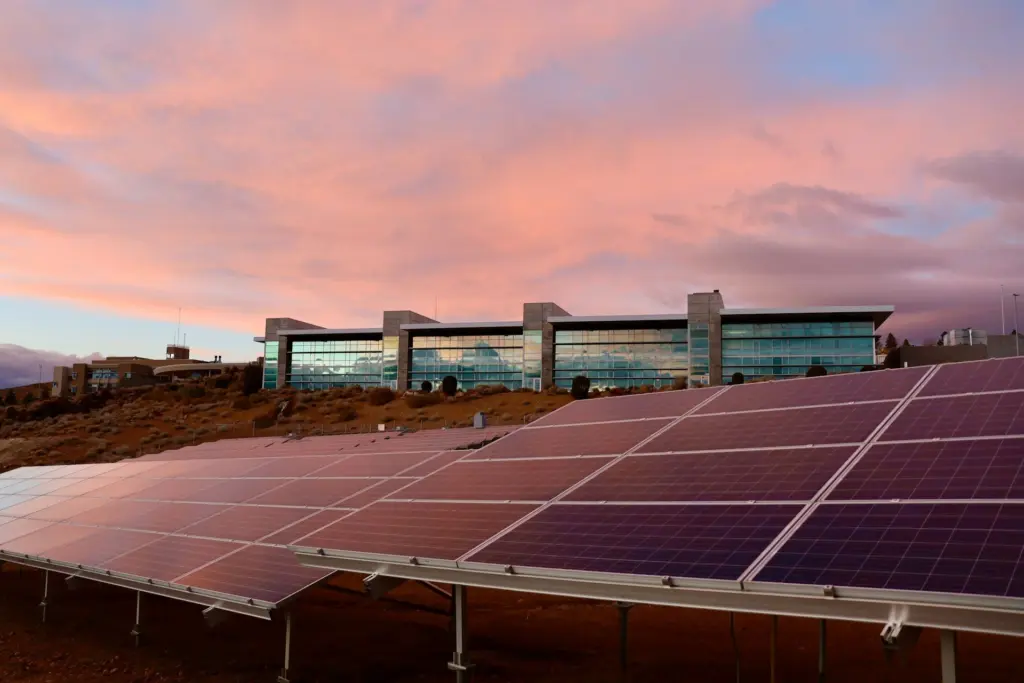(Image: National Laboratory of Argonne)
NEVADA The Energy Information Administration predicts that half of the new electricity connected to the U.S. grid this year will come from solar.
In addition to budget cuts and an order requiring Interior Secretary Doug Burgum to personally approve all solar and wind energy projects on public lands, the prognosis comes as the Trump administration has put up obstacles to the growth of clean energy.
The EPA said Wednesday that developers are on target to add 33 gigawatts of solar power in the U.S. by 2025, which would make up over half of all the new electricity generating capacity planned for the nation.
Twelve gigawatts of solar capacity were added to the grid in the first half of the year, with the remaining twenty-one gigawatts scheduled for the second half.
According to the EIA, large-scale solar power installations in the United States would hit a historic single-year high if energy companies’ plans are completely implemented.
The remaining 64 gigawatts of capacity additions in 2025 are almost entirely from natural gas, wind, and battery storage facilities.
Emissions from solar energy do not contribute to global warming. Because of this, it is essential to U.S. state efforts to decarbonize and fulfill the record-high demand for electricity from energy-intensive enterprises like data centers.
However, under President Donald Trump’s administration, many of the federal government financial incentives that fueled the growth of solar power over the past several years may go, raising questions about what will happen next.
An order to limit environmentally harmful solar and wind power projects on federal lands was signed by Interior Secretary Burgum on August 1. Burgum claimed that when compared to alternative energy sources like coal, gas, and nuclear that have far lower environmental footprints, renewable energy technologies were an ineffective use of federal lands.
A week later, the EPA declared that it was discontinuing a $7 billion program that provided funding for solar energy to states to assist in the development of solar for low-income homes. The cancellation cost Nevada a grant worth $156 million.
The majority of federal assistance for renewable energy, including tax incentives that encouraged the development of solar power, was eliminated last month by Trump’s Big Beautiful Bill.
However, a July 15 letter requiring Burgum’s personal approval for all solar and wind energy projects on public lands may be particularly important for Nevada, where over 80% of the land is under federal management.
Republican Governor Joe Lombardo replied to Burgum on August 4th, stating that the administration’s July statement had blocked solar projects that were far along in the project pipeline in Nevada.
One of the projects mentioned by Lombardo 174 Power Global’s Boulder Solar III project has not yet received regulatory approval from the federal government, despite being listed by the EIA as one among the solar projects scheduled for construction in 2025.
According to Lombardo, Nevada’s economic future depends on the growth of solar energy, which will also help the country become more independent and dominant in its energy supply.
In terms of total electricity generation from utility- and small-scale solar resources combined, Nevada came in fourth place in the US in 2024. According to the EIA, 31% of the state’s total energy came from solar.
Although Nevada’s solar capacity has increased significantly, Texas, California, and Arizona accounted for the majority of the nation’s new solar capacity in 2025.
More than 25% of the 2025 solar power development has come from Texas. Texas intends to add 9.7 gigawatts of additional solar power in the second half of the year, which is almost half of all the solar that is anticipated to be developed in the United States during that time.
About half of capacity additions in the first half of the year were in Arizona or California, with battery storage accounting for the second-largest percentage.
This year, the EIA reports that relatively little producing capacity has been retired.
Out of the 8.7 gigawatts that were supposed to be removed from service this year, only 2 gigawatts were pulled back in the first half of the year. The retirement of almost 3.6 gigawatts of electricity has been postponed or cancelled.
Coal-fired power plants will make up 71% of the retired capacity this year, with natural gas coming in second at 19%, if the other scheduled retirements go as anticipated.











